Activities of Living in Bronchiolitis Patients
VerifiedAdded on 2023/06/08
|10
|2416
|95
AI Summary
This assignment focuses on the activities of living in bronchiolitis patients, specifically breathing and body temperature. It provides an overview of how these activities are affected, how to assess and treat the symptoms, and includes a nursing care plan. The paper also discusses the Roper, Logan, and Tierney model of nursing and its twelve activities of living.
Contribute Materials
Your contribution can guide someone’s learning journey. Share your
documents today.
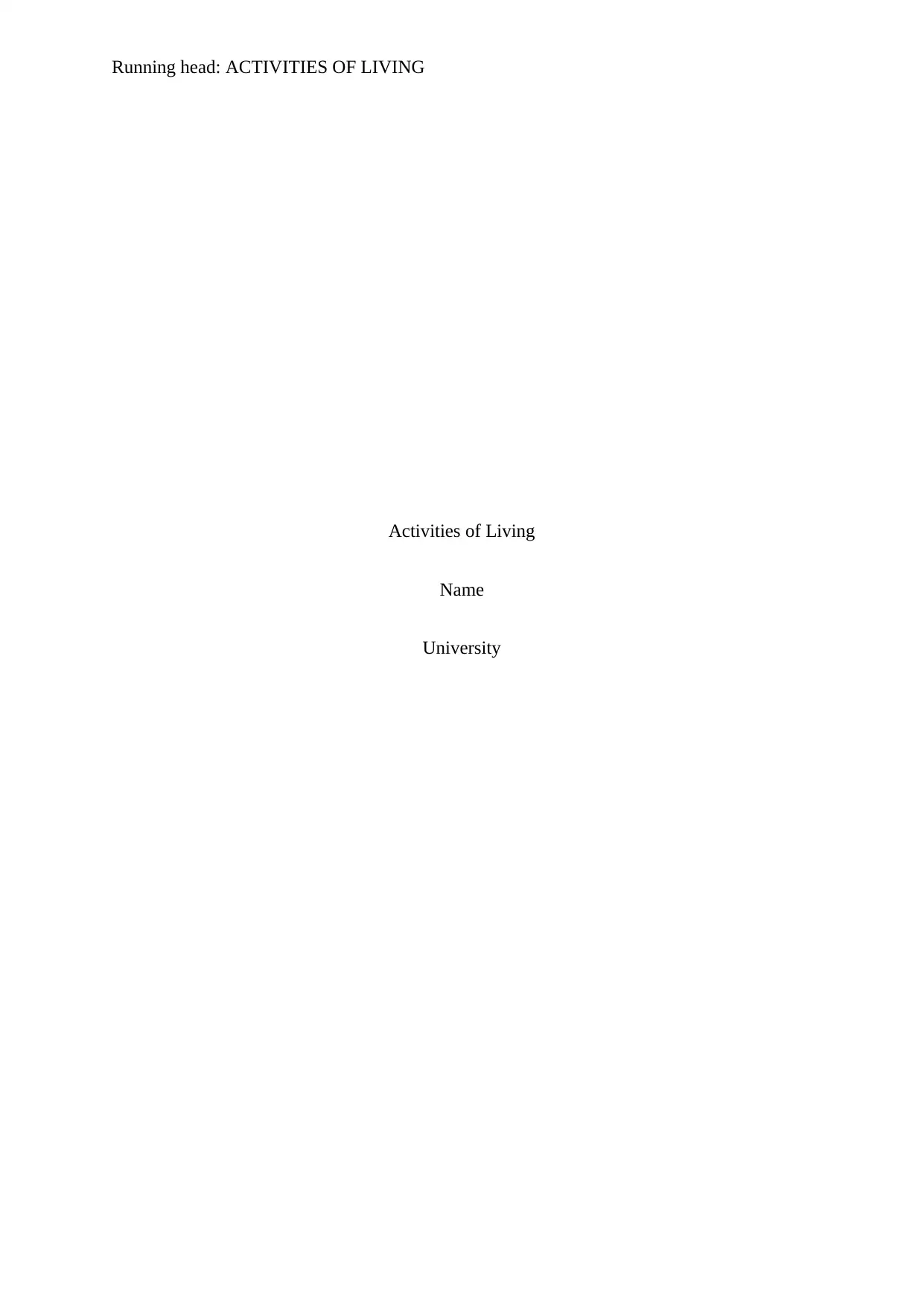
Running head: ACTIVITIES OF LIVING
Activities of Living
Name
University
Activities of Living
Name
University
Secure Best Marks with AI Grader
Need help grading? Try our AI Grader for instant feedback on your assignments.
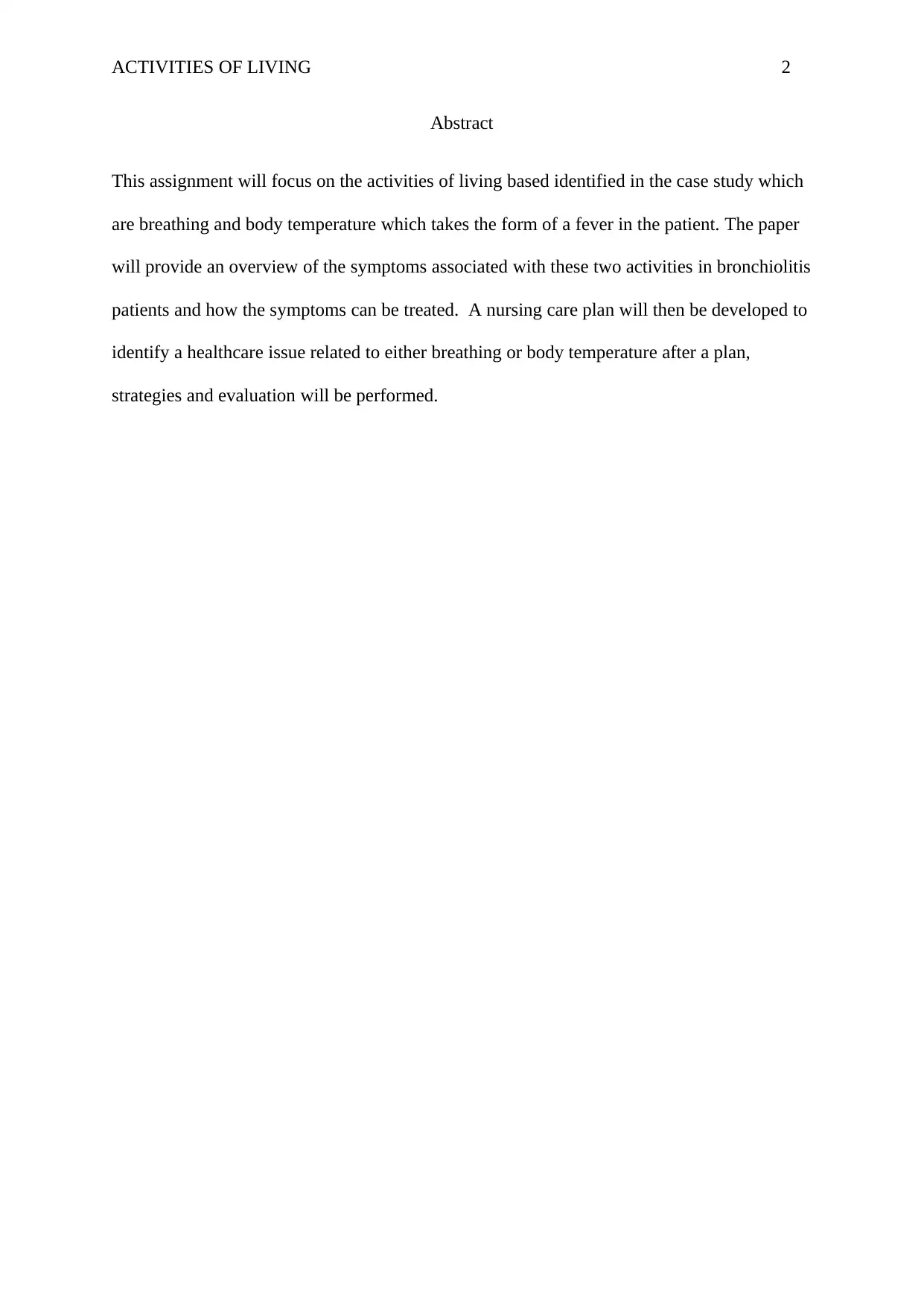
ACTIVITIES OF LIVING 2
Abstract
This assignment will focus on the activities of living based identified in the case study which
are breathing and body temperature which takes the form of a fever in the patient. The paper
will provide an overview of the symptoms associated with these two activities in bronchiolitis
patients and how the symptoms can be treated. A nursing care plan will then be developed to
identify a healthcare issue related to either breathing or body temperature after a plan,
strategies and evaluation will be performed.
Abstract
This assignment will focus on the activities of living based identified in the case study which
are breathing and body temperature which takes the form of a fever in the patient. The paper
will provide an overview of the symptoms associated with these two activities in bronchiolitis
patients and how the symptoms can be treated. A nursing care plan will then be developed to
identify a healthcare issue related to either breathing or body temperature after a plan,
strategies and evaluation will be performed.
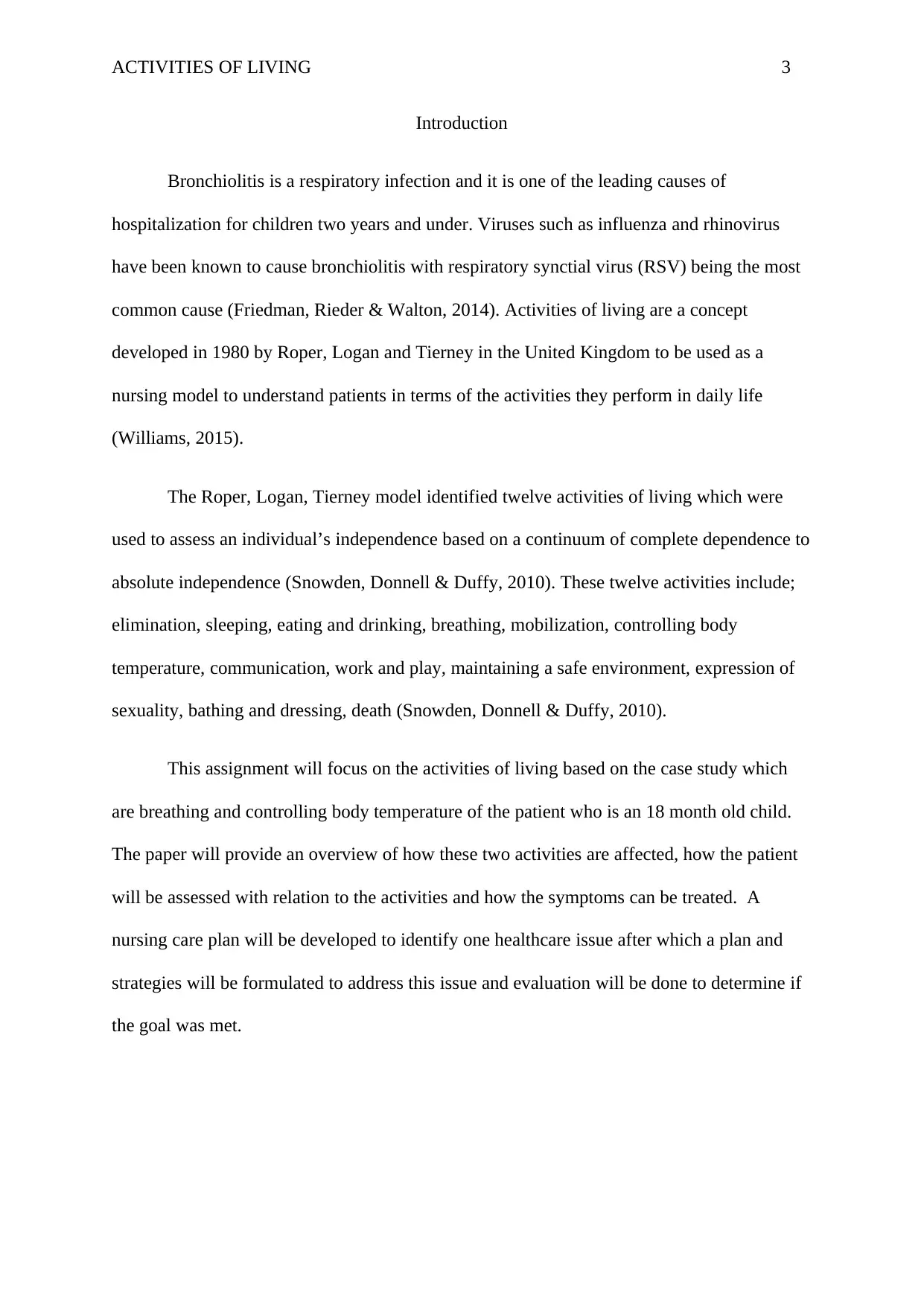
ACTIVITIES OF LIVING 3
Introduction
Bronchiolitis is a respiratory infection and it is one of the leading causes of
hospitalization for children two years and under. Viruses such as influenza and rhinovirus
have been known to cause bronchiolitis with respiratory synctial virus (RSV) being the most
common cause (Friedman, Rieder & Walton, 2014). Activities of living are a concept
developed in 1980 by Roper, Logan and Tierney in the United Kingdom to be used as a
nursing model to understand patients in terms of the activities they perform in daily life
(Williams, 2015).
The Roper, Logan, Tierney model identified twelve activities of living which were
used to assess an individual’s independence based on a continuum of complete dependence to
absolute independence (Snowden, Donnell & Duffy, 2010). These twelve activities include;
elimination, sleeping, eating and drinking, breathing, mobilization, controlling body
temperature, communication, work and play, maintaining a safe environment, expression of
sexuality, bathing and dressing, death (Snowden, Donnell & Duffy, 2010).
This assignment will focus on the activities of living based on the case study which
are breathing and controlling body temperature of the patient who is an 18 month old child.
The paper will provide an overview of how these two activities are affected, how the patient
will be assessed with relation to the activities and how the symptoms can be treated. A
nursing care plan will be developed to identify one healthcare issue after which a plan and
strategies will be formulated to address this issue and evaluation will be done to determine if
the goal was met.
Introduction
Bronchiolitis is a respiratory infection and it is one of the leading causes of
hospitalization for children two years and under. Viruses such as influenza and rhinovirus
have been known to cause bronchiolitis with respiratory synctial virus (RSV) being the most
common cause (Friedman, Rieder & Walton, 2014). Activities of living are a concept
developed in 1980 by Roper, Logan and Tierney in the United Kingdom to be used as a
nursing model to understand patients in terms of the activities they perform in daily life
(Williams, 2015).
The Roper, Logan, Tierney model identified twelve activities of living which were
used to assess an individual’s independence based on a continuum of complete dependence to
absolute independence (Snowden, Donnell & Duffy, 2010). These twelve activities include;
elimination, sleeping, eating and drinking, breathing, mobilization, controlling body
temperature, communication, work and play, maintaining a safe environment, expression of
sexuality, bathing and dressing, death (Snowden, Donnell & Duffy, 2010).
This assignment will focus on the activities of living based on the case study which
are breathing and controlling body temperature of the patient who is an 18 month old child.
The paper will provide an overview of how these two activities are affected, how the patient
will be assessed with relation to the activities and how the symptoms can be treated. A
nursing care plan will be developed to identify one healthcare issue after which a plan and
strategies will be formulated to address this issue and evaluation will be done to determine if
the goal was met.
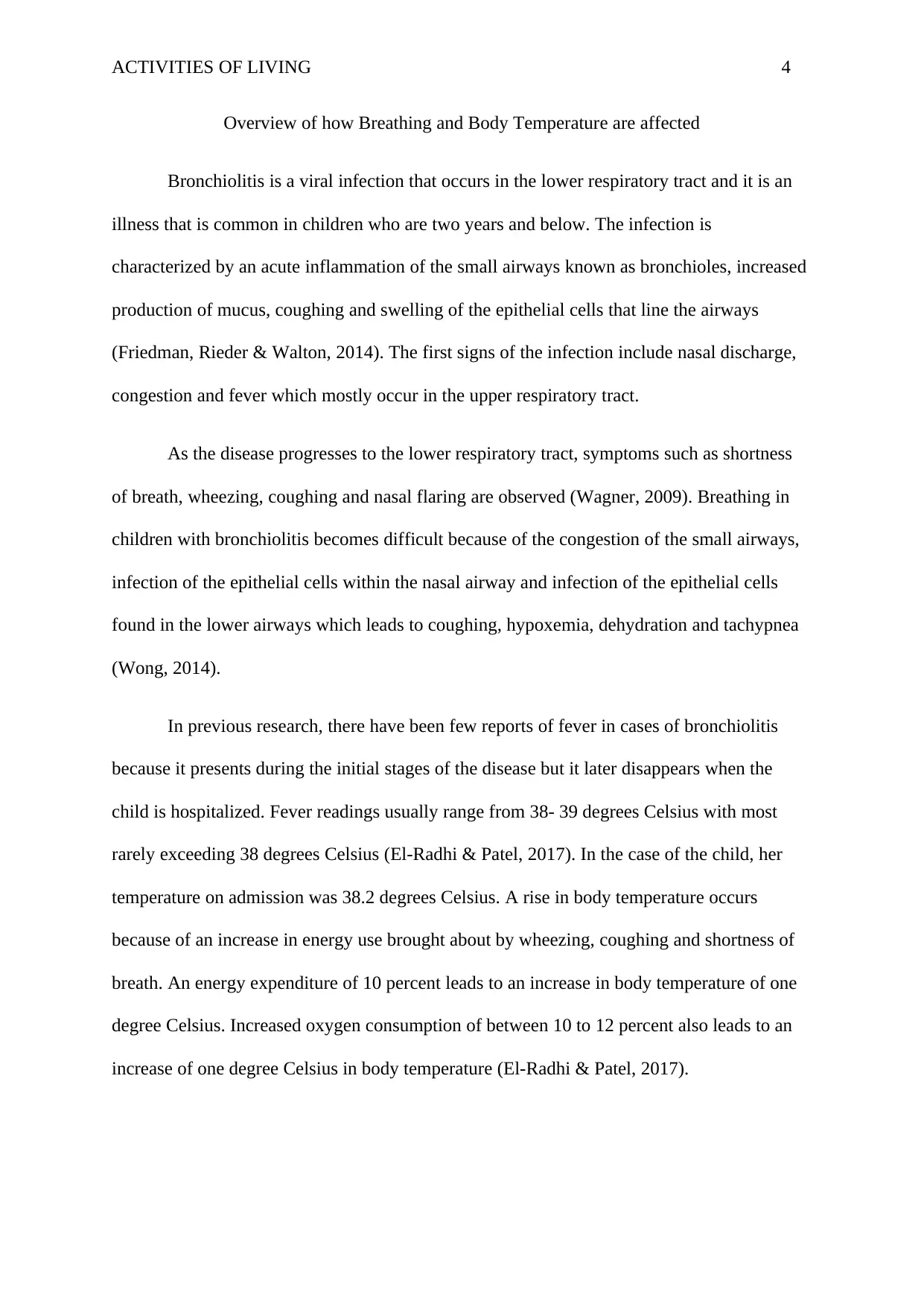
ACTIVITIES OF LIVING 4
Overview of how Breathing and Body Temperature are affected
Bronchiolitis is a viral infection that occurs in the lower respiratory tract and it is an
illness that is common in children who are two years and below. The infection is
characterized by an acute inflammation of the small airways known as bronchioles, increased
production of mucus, coughing and swelling of the epithelial cells that line the airways
(Friedman, Rieder & Walton, 2014). The first signs of the infection include nasal discharge,
congestion and fever which mostly occur in the upper respiratory tract.
As the disease progresses to the lower respiratory tract, symptoms such as shortness
of breath, wheezing, coughing and nasal flaring are observed (Wagner, 2009). Breathing in
children with bronchiolitis becomes difficult because of the congestion of the small airways,
infection of the epithelial cells within the nasal airway and infection of the epithelial cells
found in the lower airways which leads to coughing, hypoxemia, dehydration and tachypnea
(Wong, 2014).
In previous research, there have been few reports of fever in cases of bronchiolitis
because it presents during the initial stages of the disease but it later disappears when the
child is hospitalized. Fever readings usually range from 38- 39 degrees Celsius with most
rarely exceeding 38 degrees Celsius (El-Radhi & Patel, 2017). In the case of the child, her
temperature on admission was 38.2 degrees Celsius. A rise in body temperature occurs
because of an increase in energy use brought about by wheezing, coughing and shortness of
breath. An energy expenditure of 10 percent leads to an increase in body temperature of one
degree Celsius. Increased oxygen consumption of between 10 to 12 percent also leads to an
increase of one degree Celsius in body temperature (El-Radhi & Patel, 2017).
Overview of how Breathing and Body Temperature are affected
Bronchiolitis is a viral infection that occurs in the lower respiratory tract and it is an
illness that is common in children who are two years and below. The infection is
characterized by an acute inflammation of the small airways known as bronchioles, increased
production of mucus, coughing and swelling of the epithelial cells that line the airways
(Friedman, Rieder & Walton, 2014). The first signs of the infection include nasal discharge,
congestion and fever which mostly occur in the upper respiratory tract.
As the disease progresses to the lower respiratory tract, symptoms such as shortness
of breath, wheezing, coughing and nasal flaring are observed (Wagner, 2009). Breathing in
children with bronchiolitis becomes difficult because of the congestion of the small airways,
infection of the epithelial cells within the nasal airway and infection of the epithelial cells
found in the lower airways which leads to coughing, hypoxemia, dehydration and tachypnea
(Wong, 2014).
In previous research, there have been few reports of fever in cases of bronchiolitis
because it presents during the initial stages of the disease but it later disappears when the
child is hospitalized. Fever readings usually range from 38- 39 degrees Celsius with most
rarely exceeding 38 degrees Celsius (El-Radhi & Patel, 2017). In the case of the child, her
temperature on admission was 38.2 degrees Celsius. A rise in body temperature occurs
because of an increase in energy use brought about by wheezing, coughing and shortness of
breath. An energy expenditure of 10 percent leads to an increase in body temperature of one
degree Celsius. Increased oxygen consumption of between 10 to 12 percent also leads to an
increase of one degree Celsius in body temperature (El-Radhi & Patel, 2017).
Secure Best Marks with AI Grader
Need help grading? Try our AI Grader for instant feedback on your assignments.
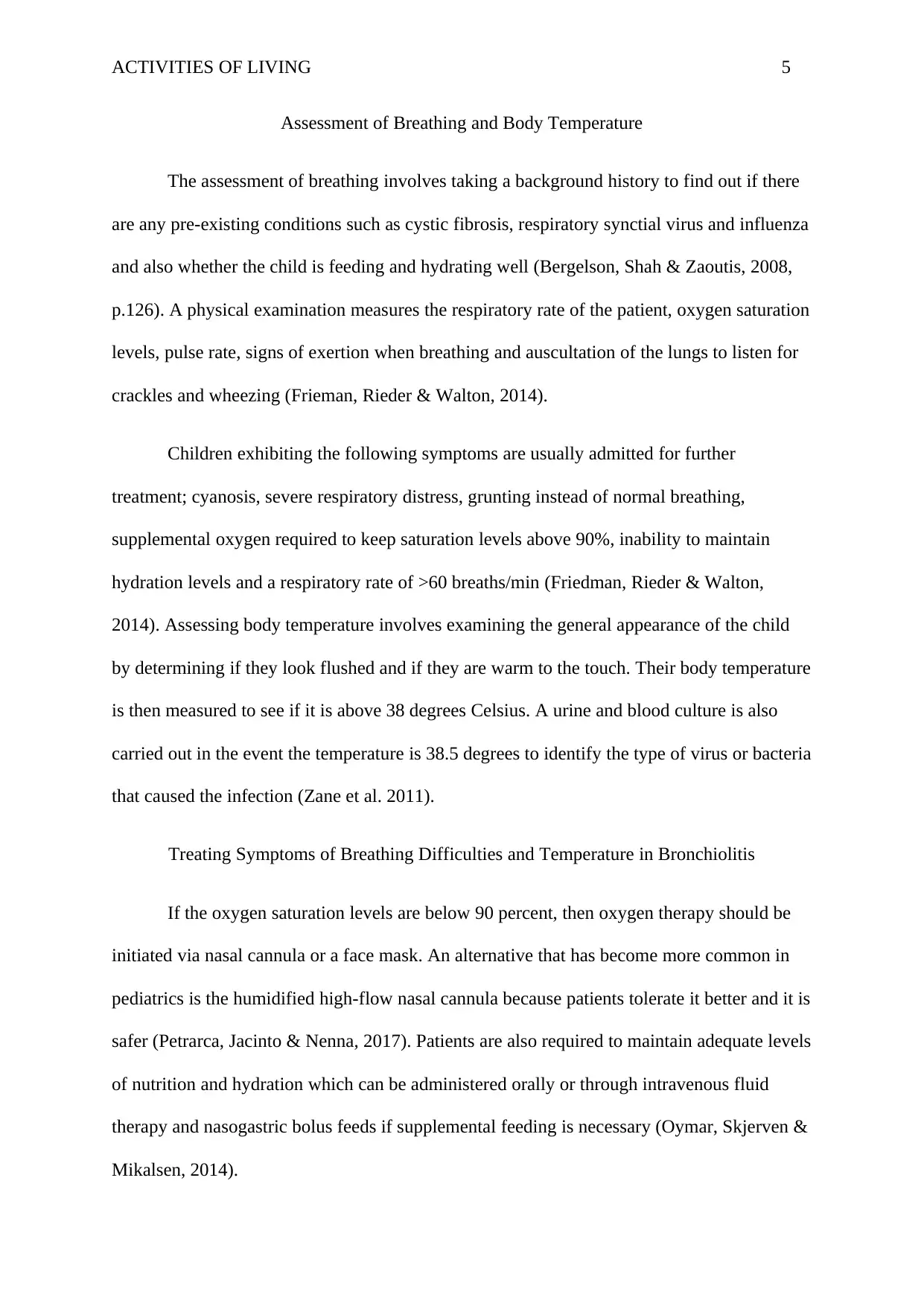
ACTIVITIES OF LIVING 5
Assessment of Breathing and Body Temperature
The assessment of breathing involves taking a background history to find out if there
are any pre-existing conditions such as cystic fibrosis, respiratory synctial virus and influenza
and also whether the child is feeding and hydrating well (Bergelson, Shah & Zaoutis, 2008,
p.126). A physical examination measures the respiratory rate of the patient, oxygen saturation
levels, pulse rate, signs of exertion when breathing and auscultation of the lungs to listen for
crackles and wheezing (Frieman, Rieder & Walton, 2014).
Children exhibiting the following symptoms are usually admitted for further
treatment; cyanosis, severe respiratory distress, grunting instead of normal breathing,
supplemental oxygen required to keep saturation levels above 90%, inability to maintain
hydration levels and a respiratory rate of >60 breaths/min (Friedman, Rieder & Walton,
2014). Assessing body temperature involves examining the general appearance of the child
by determining if they look flushed and if they are warm to the touch. Their body temperature
is then measured to see if it is above 38 degrees Celsius. A urine and blood culture is also
carried out in the event the temperature is 38.5 degrees to identify the type of virus or bacteria
that caused the infection (Zane et al. 2011).
Treating Symptoms of Breathing Difficulties and Temperature in Bronchiolitis
If the oxygen saturation levels are below 90 percent, then oxygen therapy should be
initiated via nasal cannula or a face mask. An alternative that has become more common in
pediatrics is the humidified high-flow nasal cannula because patients tolerate it better and it is
safer (Petrarca, Jacinto & Nenna, 2017). Patients are also required to maintain adequate levels
of nutrition and hydration which can be administered orally or through intravenous fluid
therapy and nasogastric bolus feeds if supplemental feeding is necessary (Oymar, Skjerven &
Mikalsen, 2014).
Assessment of Breathing and Body Temperature
The assessment of breathing involves taking a background history to find out if there
are any pre-existing conditions such as cystic fibrosis, respiratory synctial virus and influenza
and also whether the child is feeding and hydrating well (Bergelson, Shah & Zaoutis, 2008,
p.126). A physical examination measures the respiratory rate of the patient, oxygen saturation
levels, pulse rate, signs of exertion when breathing and auscultation of the lungs to listen for
crackles and wheezing (Frieman, Rieder & Walton, 2014).
Children exhibiting the following symptoms are usually admitted for further
treatment; cyanosis, severe respiratory distress, grunting instead of normal breathing,
supplemental oxygen required to keep saturation levels above 90%, inability to maintain
hydration levels and a respiratory rate of >60 breaths/min (Friedman, Rieder & Walton,
2014). Assessing body temperature involves examining the general appearance of the child
by determining if they look flushed and if they are warm to the touch. Their body temperature
is then measured to see if it is above 38 degrees Celsius. A urine and blood culture is also
carried out in the event the temperature is 38.5 degrees to identify the type of virus or bacteria
that caused the infection (Zane et al. 2011).
Treating Symptoms of Breathing Difficulties and Temperature in Bronchiolitis
If the oxygen saturation levels are below 90 percent, then oxygen therapy should be
initiated via nasal cannula or a face mask. An alternative that has become more common in
pediatrics is the humidified high-flow nasal cannula because patients tolerate it better and it is
safer (Petrarca, Jacinto & Nenna, 2017). Patients are also required to maintain adequate levels
of nutrition and hydration which can be administered orally or through intravenous fluid
therapy and nasogastric bolus feeds if supplemental feeding is necessary (Oymar, Skjerven &
Mikalsen, 2014).
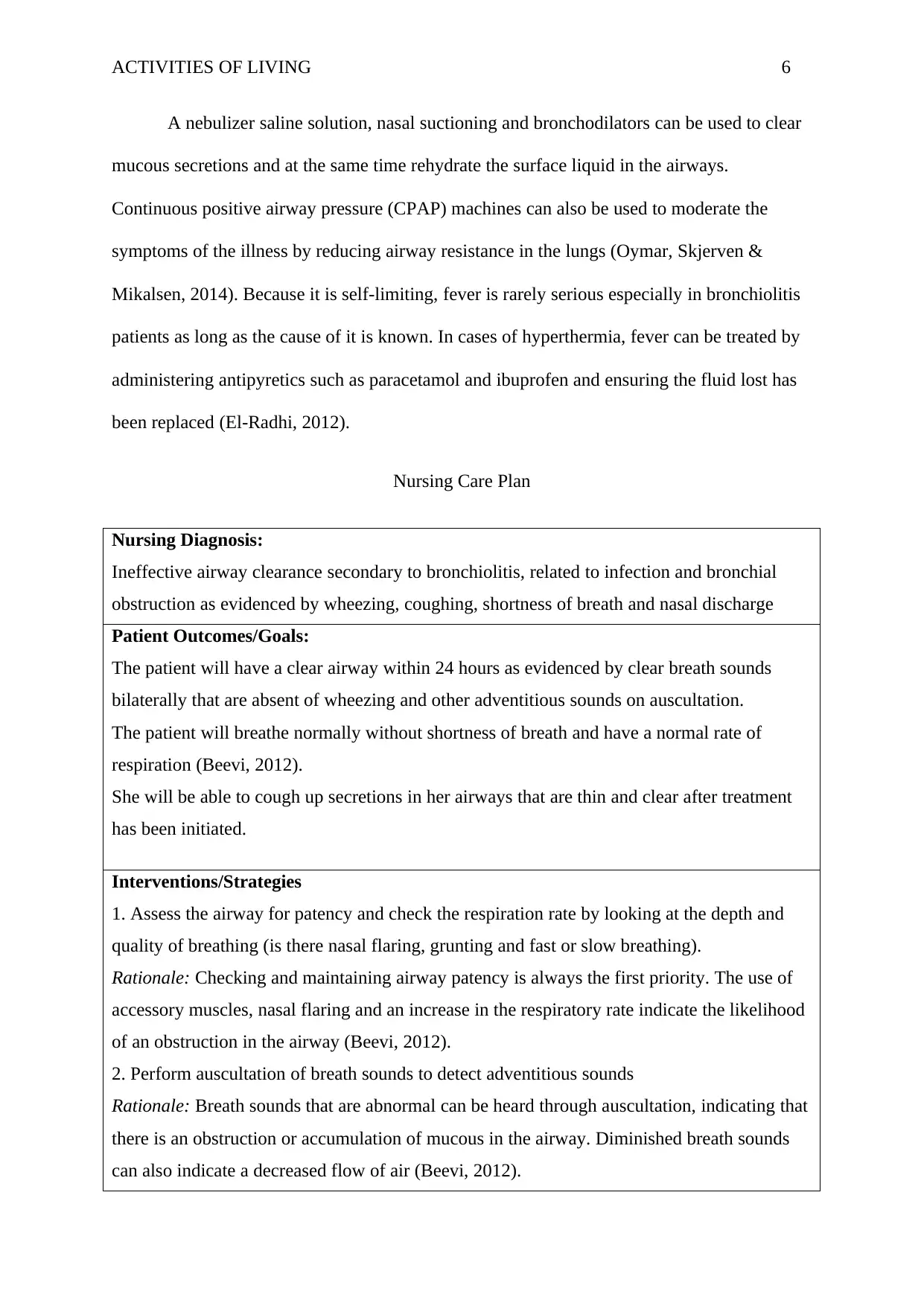
ACTIVITIES OF LIVING 6
A nebulizer saline solution, nasal suctioning and bronchodilators can be used to clear
mucous secretions and at the same time rehydrate the surface liquid in the airways.
Continuous positive airway pressure (CPAP) machines can also be used to moderate the
symptoms of the illness by reducing airway resistance in the lungs (Oymar, Skjerven &
Mikalsen, 2014). Because it is self-limiting, fever is rarely serious especially in bronchiolitis
patients as long as the cause of it is known. In cases of hyperthermia, fever can be treated by
administering antipyretics such as paracetamol and ibuprofen and ensuring the fluid lost has
been replaced (El-Radhi, 2012).
Nursing Care Plan
Nursing Diagnosis:
Ineffective airway clearance secondary to bronchiolitis, related to infection and bronchial
obstruction as evidenced by wheezing, coughing, shortness of breath and nasal discharge
Patient Outcomes/Goals:
The patient will have a clear airway within 24 hours as evidenced by clear breath sounds
bilaterally that are absent of wheezing and other adventitious sounds on auscultation.
The patient will breathe normally without shortness of breath and have a normal rate of
respiration (Beevi, 2012).
She will be able to cough up secretions in her airways that are thin and clear after treatment
has been initiated.
Interventions/Strategies
1. Assess the airway for patency and check the respiration rate by looking at the depth and
quality of breathing (is there nasal flaring, grunting and fast or slow breathing).
Rationale: Checking and maintaining airway patency is always the first priority. The use of
accessory muscles, nasal flaring and an increase in the respiratory rate indicate the likelihood
of an obstruction in the airway (Beevi, 2012).
2. Perform auscultation of breath sounds to detect adventitious sounds
Rationale: Breath sounds that are abnormal can be heard through auscultation, indicating that
there is an obstruction or accumulation of mucous in the airway. Diminished breath sounds
can also indicate a decreased flow of air (Beevi, 2012).
A nebulizer saline solution, nasal suctioning and bronchodilators can be used to clear
mucous secretions and at the same time rehydrate the surface liquid in the airways.
Continuous positive airway pressure (CPAP) machines can also be used to moderate the
symptoms of the illness by reducing airway resistance in the lungs (Oymar, Skjerven &
Mikalsen, 2014). Because it is self-limiting, fever is rarely serious especially in bronchiolitis
patients as long as the cause of it is known. In cases of hyperthermia, fever can be treated by
administering antipyretics such as paracetamol and ibuprofen and ensuring the fluid lost has
been replaced (El-Radhi, 2012).
Nursing Care Plan
Nursing Diagnosis:
Ineffective airway clearance secondary to bronchiolitis, related to infection and bronchial
obstruction as evidenced by wheezing, coughing, shortness of breath and nasal discharge
Patient Outcomes/Goals:
The patient will have a clear airway within 24 hours as evidenced by clear breath sounds
bilaterally that are absent of wheezing and other adventitious sounds on auscultation.
The patient will breathe normally without shortness of breath and have a normal rate of
respiration (Beevi, 2012).
She will be able to cough up secretions in her airways that are thin and clear after treatment
has been initiated.
Interventions/Strategies
1. Assess the airway for patency and check the respiration rate by looking at the depth and
quality of breathing (is there nasal flaring, grunting and fast or slow breathing).
Rationale: Checking and maintaining airway patency is always the first priority. The use of
accessory muscles, nasal flaring and an increase in the respiratory rate indicate the likelihood
of an obstruction in the airway (Beevi, 2012).
2. Perform auscultation of breath sounds to detect adventitious sounds
Rationale: Breath sounds that are abnormal can be heard through auscultation, indicating that
there is an obstruction or accumulation of mucous in the airway. Diminished breath sounds
can also indicate a decreased flow of air (Beevi, 2012).
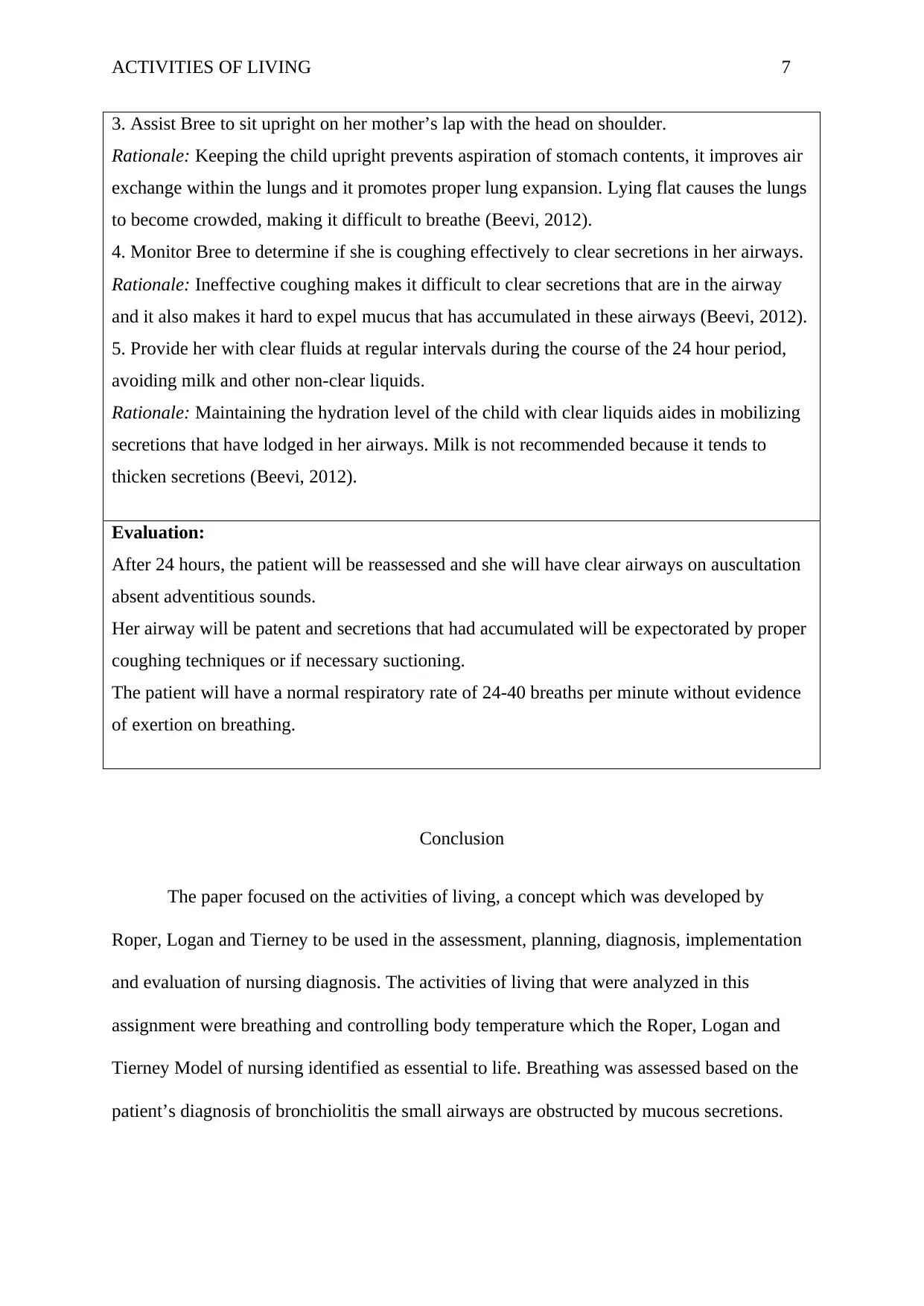
ACTIVITIES OF LIVING 7
3. Assist Bree to sit upright on her mother’s lap with the head on shoulder.
Rationale: Keeping the child upright prevents aspiration of stomach contents, it improves air
exchange within the lungs and it promotes proper lung expansion. Lying flat causes the lungs
to become crowded, making it difficult to breathe (Beevi, 2012).
4. Monitor Bree to determine if she is coughing effectively to clear secretions in her airways.
Rationale: Ineffective coughing makes it difficult to clear secretions that are in the airway
and it also makes it hard to expel mucus that has accumulated in these airways (Beevi, 2012).
5. Provide her with clear fluids at regular intervals during the course of the 24 hour period,
avoiding milk and other non-clear liquids.
Rationale: Maintaining the hydration level of the child with clear liquids aides in mobilizing
secretions that have lodged in her airways. Milk is not recommended because it tends to
thicken secretions (Beevi, 2012).
Evaluation:
After 24 hours, the patient will be reassessed and she will have clear airways on auscultation
absent adventitious sounds.
Her airway will be patent and secretions that had accumulated will be expectorated by proper
coughing techniques or if necessary suctioning.
The patient will have a normal respiratory rate of 24-40 breaths per minute without evidence
of exertion on breathing.
Conclusion
The paper focused on the activities of living, a concept which was developed by
Roper, Logan and Tierney to be used in the assessment, planning, diagnosis, implementation
and evaluation of nursing diagnosis. The activities of living that were analyzed in this
assignment were breathing and controlling body temperature which the Roper, Logan and
Tierney Model of nursing identified as essential to life. Breathing was assessed based on the
patient’s diagnosis of bronchiolitis the small airways are obstructed by mucous secretions.
3. Assist Bree to sit upright on her mother’s lap with the head on shoulder.
Rationale: Keeping the child upright prevents aspiration of stomach contents, it improves air
exchange within the lungs and it promotes proper lung expansion. Lying flat causes the lungs
to become crowded, making it difficult to breathe (Beevi, 2012).
4. Monitor Bree to determine if she is coughing effectively to clear secretions in her airways.
Rationale: Ineffective coughing makes it difficult to clear secretions that are in the airway
and it also makes it hard to expel mucus that has accumulated in these airways (Beevi, 2012).
5. Provide her with clear fluids at regular intervals during the course of the 24 hour period,
avoiding milk and other non-clear liquids.
Rationale: Maintaining the hydration level of the child with clear liquids aides in mobilizing
secretions that have lodged in her airways. Milk is not recommended because it tends to
thicken secretions (Beevi, 2012).
Evaluation:
After 24 hours, the patient will be reassessed and she will have clear airways on auscultation
absent adventitious sounds.
Her airway will be patent and secretions that had accumulated will be expectorated by proper
coughing techniques or if necessary suctioning.
The patient will have a normal respiratory rate of 24-40 breaths per minute without evidence
of exertion on breathing.
Conclusion
The paper focused on the activities of living, a concept which was developed by
Roper, Logan and Tierney to be used in the assessment, planning, diagnosis, implementation
and evaluation of nursing diagnosis. The activities of living that were analyzed in this
assignment were breathing and controlling body temperature which the Roper, Logan and
Tierney Model of nursing identified as essential to life. Breathing was assessed based on the
patient’s diagnosis of bronchiolitis the small airways are obstructed by mucous secretions.
Paraphrase This Document
Need a fresh take? Get an instant paraphrase of this document with our AI Paraphraser
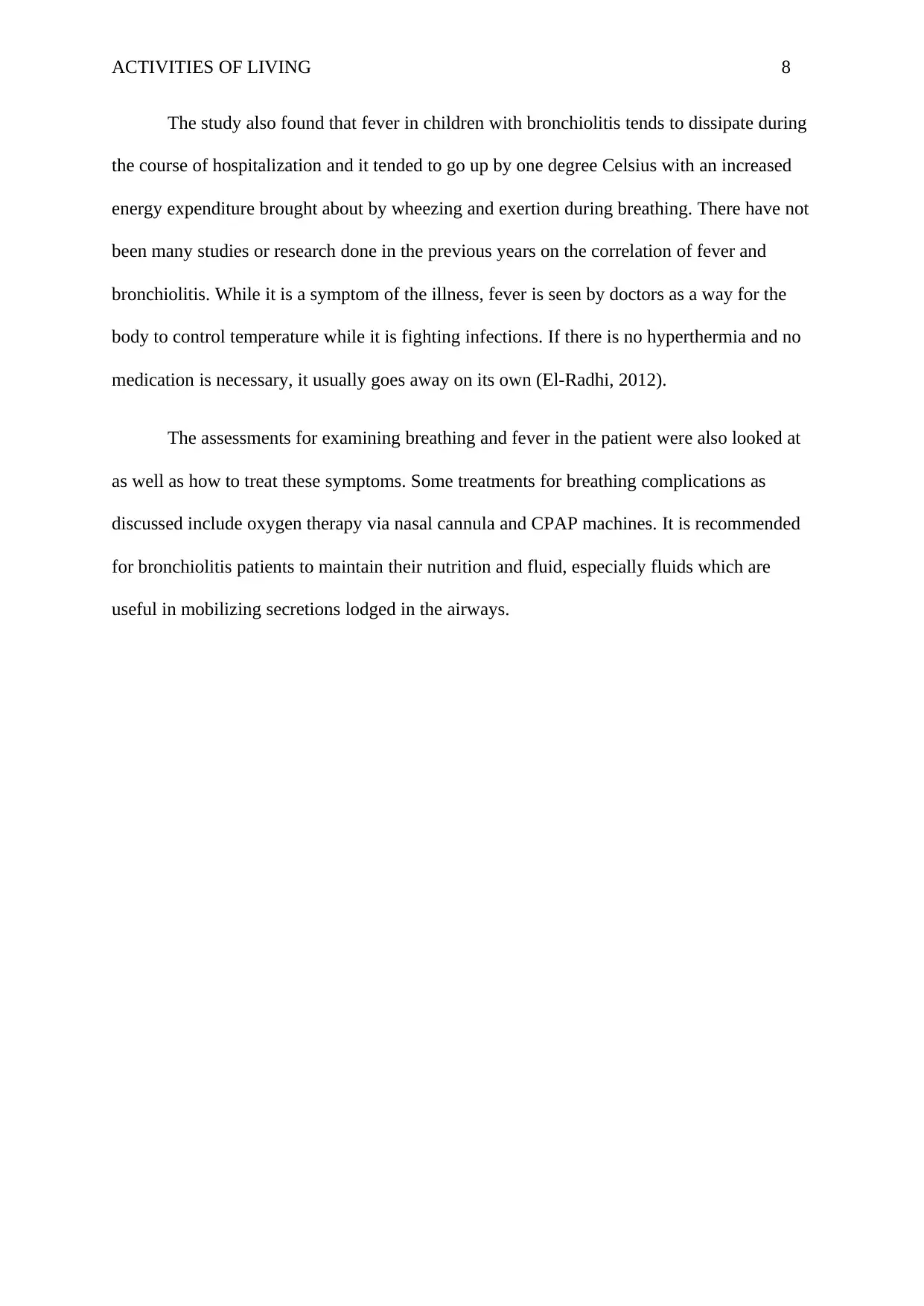
ACTIVITIES OF LIVING 8
The study also found that fever in children with bronchiolitis tends to dissipate during
the course of hospitalization and it tended to go up by one degree Celsius with an increased
energy expenditure brought about by wheezing and exertion during breathing. There have not
been many studies or research done in the previous years on the correlation of fever and
bronchiolitis. While it is a symptom of the illness, fever is seen by doctors as a way for the
body to control temperature while it is fighting infections. If there is no hyperthermia and no
medication is necessary, it usually goes away on its own (El-Radhi, 2012).
The assessments for examining breathing and fever in the patient were also looked at
as well as how to treat these symptoms. Some treatments for breathing complications as
discussed include oxygen therapy via nasal cannula and CPAP machines. It is recommended
for bronchiolitis patients to maintain their nutrition and fluid, especially fluids which are
useful in mobilizing secretions lodged in the airways.
The study also found that fever in children with bronchiolitis tends to dissipate during
the course of hospitalization and it tended to go up by one degree Celsius with an increased
energy expenditure brought about by wheezing and exertion during breathing. There have not
been many studies or research done in the previous years on the correlation of fever and
bronchiolitis. While it is a symptom of the illness, fever is seen by doctors as a way for the
body to control temperature while it is fighting infections. If there is no hyperthermia and no
medication is necessary, it usually goes away on its own (El-Radhi, 2012).
The assessments for examining breathing and fever in the patient were also looked at
as well as how to treat these symptoms. Some treatments for breathing complications as
discussed include oxygen therapy via nasal cannula and CPAP machines. It is recommended
for bronchiolitis patients to maintain their nutrition and fluid, especially fluids which are
useful in mobilizing secretions lodged in the airways.
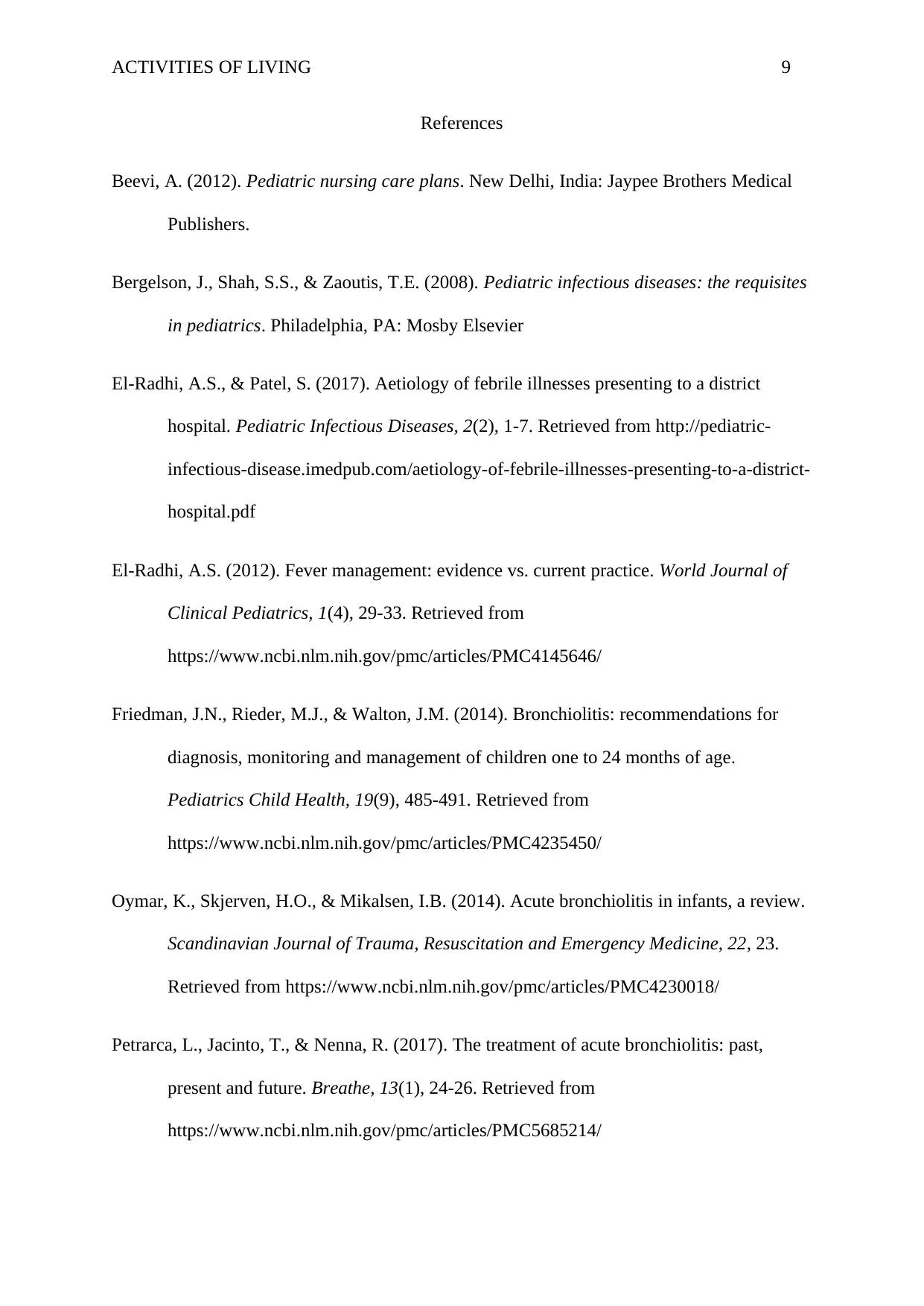
ACTIVITIES OF LIVING 9
References
Beevi, A. (2012). Pediatric nursing care plans. New Delhi, India: Jaypee Brothers Medical
Publishers.
Bergelson, J., Shah, S.S., & Zaoutis, T.E. (2008). Pediatric infectious diseases: the requisites
in pediatrics. Philadelphia, PA: Mosby Elsevier
El-Radhi, A.S., & Patel, S. (2017). Aetiology of febrile illnesses presenting to a district
hospital. Pediatric Infectious Diseases, 2(2), 1-7. Retrieved from http://pediatric-
infectious-disease.imedpub.com/aetiology-of-febrile-illnesses-presenting-to-a-district-
hospital.pdf
El-Radhi, A.S. (2012). Fever management: evidence vs. current practice. World Journal of
Clinical Pediatrics, 1(4), 29-33. Retrieved from
https://www.ncbi.nlm.nih.gov/pmc/articles/PMC4145646/
Friedman, J.N., Rieder, M.J., & Walton, J.M. (2014). Bronchiolitis: recommendations for
diagnosis, monitoring and management of children one to 24 months of age.
Pediatrics Child Health, 19(9), 485-491. Retrieved from
https://www.ncbi.nlm.nih.gov/pmc/articles/PMC4235450/
Oymar, K., Skjerven, H.O., & Mikalsen, I.B. (2014). Acute bronchiolitis in infants, a review.
Scandinavian Journal of Trauma, Resuscitation and Emergency Medicine, 22, 23.
Retrieved from https://www.ncbi.nlm.nih.gov/pmc/articles/PMC4230018/
Petrarca, L., Jacinto, T., & Nenna, R. (2017). The treatment of acute bronchiolitis: past,
present and future. Breathe, 13(1), 24-26. Retrieved from
https://www.ncbi.nlm.nih.gov/pmc/articles/PMC5685214/
References
Beevi, A. (2012). Pediatric nursing care plans. New Delhi, India: Jaypee Brothers Medical
Publishers.
Bergelson, J., Shah, S.S., & Zaoutis, T.E. (2008). Pediatric infectious diseases: the requisites
in pediatrics. Philadelphia, PA: Mosby Elsevier
El-Radhi, A.S., & Patel, S. (2017). Aetiology of febrile illnesses presenting to a district
hospital. Pediatric Infectious Diseases, 2(2), 1-7. Retrieved from http://pediatric-
infectious-disease.imedpub.com/aetiology-of-febrile-illnesses-presenting-to-a-district-
hospital.pdf
El-Radhi, A.S. (2012). Fever management: evidence vs. current practice. World Journal of
Clinical Pediatrics, 1(4), 29-33. Retrieved from
https://www.ncbi.nlm.nih.gov/pmc/articles/PMC4145646/
Friedman, J.N., Rieder, M.J., & Walton, J.M. (2014). Bronchiolitis: recommendations for
diagnosis, monitoring and management of children one to 24 months of age.
Pediatrics Child Health, 19(9), 485-491. Retrieved from
https://www.ncbi.nlm.nih.gov/pmc/articles/PMC4235450/
Oymar, K., Skjerven, H.O., & Mikalsen, I.B. (2014). Acute bronchiolitis in infants, a review.
Scandinavian Journal of Trauma, Resuscitation and Emergency Medicine, 22, 23.
Retrieved from https://www.ncbi.nlm.nih.gov/pmc/articles/PMC4230018/
Petrarca, L., Jacinto, T., & Nenna, R. (2017). The treatment of acute bronchiolitis: past,
present and future. Breathe, 13(1), 24-26. Retrieved from
https://www.ncbi.nlm.nih.gov/pmc/articles/PMC5685214/
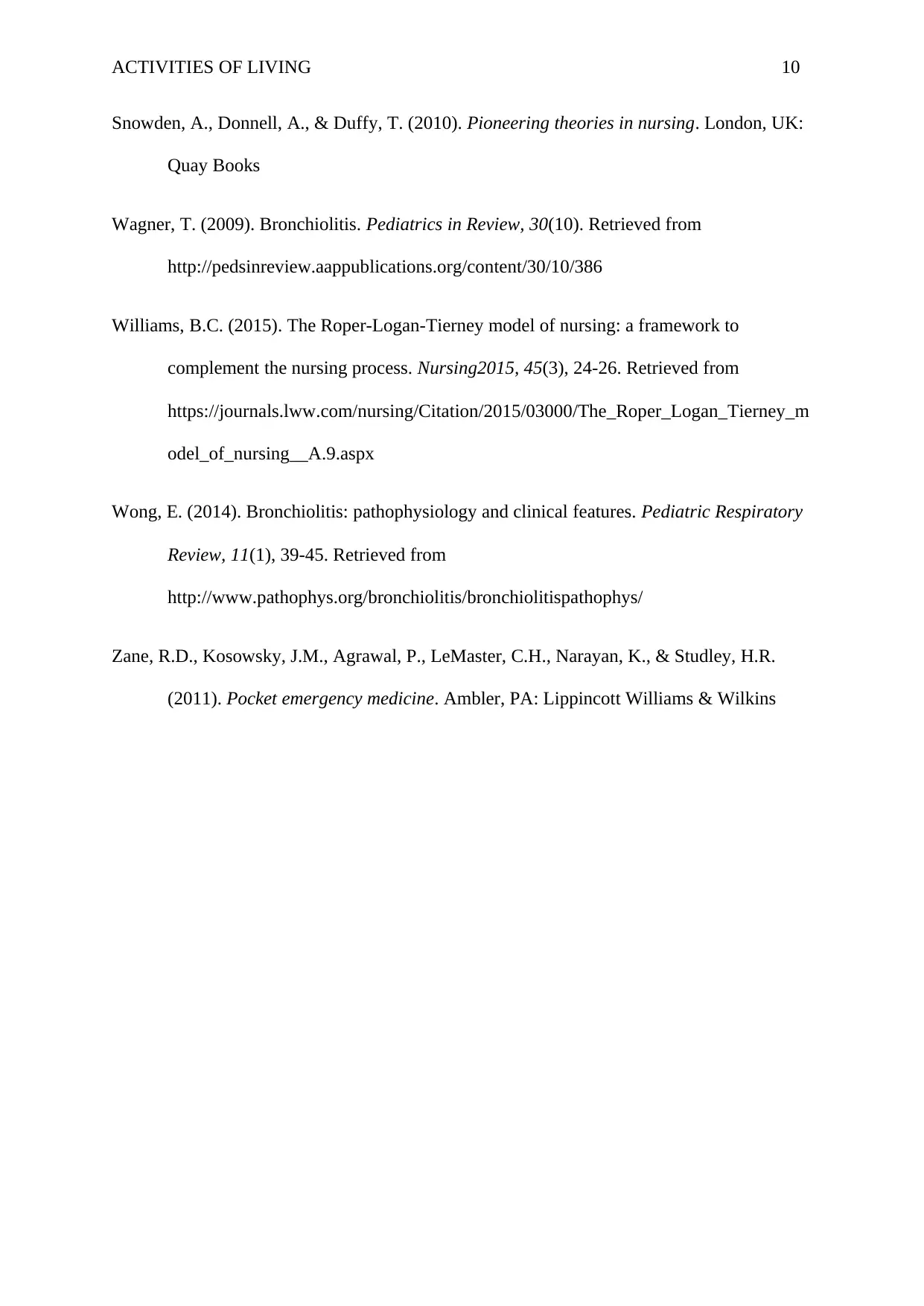
ACTIVITIES OF LIVING 10
Snowden, A., Donnell, A., & Duffy, T. (2010). Pioneering theories in nursing. London, UK:
Quay Books
Wagner, T. (2009). Bronchiolitis. Pediatrics in Review, 30(10). Retrieved from
http://pedsinreview.aappublications.org/content/30/10/386
Williams, B.C. (2015). The Roper-Logan-Tierney model of nursing: a framework to
complement the nursing process. Nursing2015, 45(3), 24-26. Retrieved from
https://journals.lww.com/nursing/Citation/2015/03000/The_Roper_Logan_Tierney_m
odel_of_nursing__A.9.aspx
Wong, E. (2014). Bronchiolitis: pathophysiology and clinical features. Pediatric Respiratory
Review, 11(1), 39-45. Retrieved from
http://www.pathophys.org/bronchiolitis/bronchiolitispathophys/
Zane, R.D., Kosowsky, J.M., Agrawal, P., LeMaster, C.H., Narayan, K., & Studley, H.R.
(2011). Pocket emergency medicine. Ambler, PA: Lippincott Williams & Wilkins
Snowden, A., Donnell, A., & Duffy, T. (2010). Pioneering theories in nursing. London, UK:
Quay Books
Wagner, T. (2009). Bronchiolitis. Pediatrics in Review, 30(10). Retrieved from
http://pedsinreview.aappublications.org/content/30/10/386
Williams, B.C. (2015). The Roper-Logan-Tierney model of nursing: a framework to
complement the nursing process. Nursing2015, 45(3), 24-26. Retrieved from
https://journals.lww.com/nursing/Citation/2015/03000/The_Roper_Logan_Tierney_m
odel_of_nursing__A.9.aspx
Wong, E. (2014). Bronchiolitis: pathophysiology and clinical features. Pediatric Respiratory
Review, 11(1), 39-45. Retrieved from
http://www.pathophys.org/bronchiolitis/bronchiolitispathophys/
Zane, R.D., Kosowsky, J.M., Agrawal, P., LeMaster, C.H., Narayan, K., & Studley, H.R.
(2011). Pocket emergency medicine. Ambler, PA: Lippincott Williams & Wilkins
1 out of 10
Your All-in-One AI-Powered Toolkit for Academic Success.
+13062052269
info@desklib.com
Available 24*7 on WhatsApp / Email
![[object Object]](/_next/static/media/star-bottom.7253800d.svg)
Unlock your academic potential
© 2024 | Zucol Services PVT LTD | All rights reserved.
